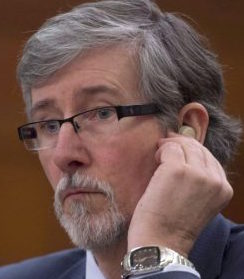Federal privacy watchdog wants info on agency tracking peaceful protests

Government Operations Centre comes under privacy office scrutiny over monitoring of peaceful protests, academic panels
By Alex Boutilier Toronto Star
OTTAWA—Canada’s privacy watchdog wants more information on a central government agency keeping tabs on peaceful protests.
Documents obtained by the Star show privacy commissioner Daniel Therrien’s office has asked the Government Operations Centre (GOC) to review its tracking of lawful protest and dissent.
“In (the letter), we asked that a more detailed analysis of the privacy risks relating to monitoring of public protests and demonstrations be undertaken and given to us to review,” Tobi Cohen, a spokesperson for Therrien, wrote in a statement.
“We are actively consulting with Public Safety on this file to make sure that we, and the Canadian public, have a full understanding of how personal information is being collected and shared under this program.”
The GOC provides 24/7 “situational awareness” for the federal government, and is supposed to help co-ordinate Ottawa’s response to natural disasters or threats to infrastructure.
But in late 2014, it was revealed the GOC has collected information on more than 800 peaceful protests, demonstrations and academic panels since 2006.
Therrien’s office refused to release the letter detailing the concerns with GOC operations, telling the Star to go through the access to information process.
The GOC does not conduct surveillance on protests, but serves as an intelligence clearing house for the federal government. That information can be as innocuous as Facebook event posts, to as detailed as RCMP and CSIS reports on incidents. The agency said no personal information is collected or shared.
According to its privacy impact assessment, the agency takes an “all-hazard” approach, including “civic disturbances.”
Documents tabled in Parliament in 2014 showed the GOC had information on events like a rally for veterans on Parliament Hill, a public panel discussion in Toronto on the oilsands, and a number of vigils and marches for missing and murdered indigenous women.
In June 2014, the Ottawa Citizen reported that the GOC asked government departments for help in compiling a “comprehensive listing of all known demonstrations” across the country.
The revelations drew the ire of the Liberals while in opposition.
“The government has frozen out and refused to meet with indigenous peoples and environmental groups, yet devotes disproportionate resources to spying on them,” Scott Brison, now a senior cabinet minister, said in September 2014.
“It would be much better to engage these groups meaningfully than to skulk around their meetings to hear what they’re thinking.”
But the GOC’s operations do not appear to have changed in the early days of the new Liberal government. The Star repeatedly reached out last week to the office of Public Safety and Emergency Preparedness Minister Ralph Goodale, but he was unavailable to comment.
“We remain committed to protecting the safety and security of Canadians while also protecting their rights and freedoms,” Public Safety spokesperson Jean Paul Duval wrote in an email.
“We have worked with the Office of the Privacy Commissioner to seek their advice and to ensure that GOC activities are in accordance with the personal information-handling practices of the federal government outlined in (Canadian privacy law).”
Duval noted the GOC completed its first “privacy impact assessment” — a routine government check on the risk to Canadians’ privacy for various programs — in May 2013.
“Subsequently, in August 2013 and October 2014, the privacy commissioner provided the GOC with various recommendations,” Duval wrote. “More specifically, some of the recommendations were around managing the potential for accidental or unintentional receipt of personal or private information outside of the GOC’s mandate, and to ensure correct disposal of that information.”
Examples of protests and demonstrations tracked by the Government Operations Centre:
-A January 2006 protest on the war in Afghanistan and Bay Street’s “involvement” in Toronto, reported on by the Department of Justice.
-A January 2007 demonstration by Amnesty International in Vancouver, tracked through media reports.
-A May 2007 announcement by the Assembly of First Nations on a co-ordinator for a national day of action, tracked by Indigenous Affairs. Subsequent AFN demonstrations were tracked by various agencies, including the Integrated Terrorism Assessment Centre.
-A series of Pro-Tamil rallies in Toronto, Ottawa and Montreal in April 2009.
-A June 2010 rally for the University of Winnipeg Aboriginal Student Association, monitored by Indigenous Affairs.
-As Occupy camps were set up across the United States and Canada in late 2011, the Government Operations Centre collected media reports on various locations.
-Public service union rallies in Ottawa during February 2012 were monitored by “PS” — which could stand for the general “public service,” or Public Safety Canada.
-A rally involving Ben Powless, a “Mohawk environmental activist,” in Toronto in August 2013, monitored by the RCMP.
-The May 2014 edition of the annual anti-abortion “March for Life” on Parliament Hill, monitored by the Privy Council Office Crisis Management Centre.









Leave a Reply